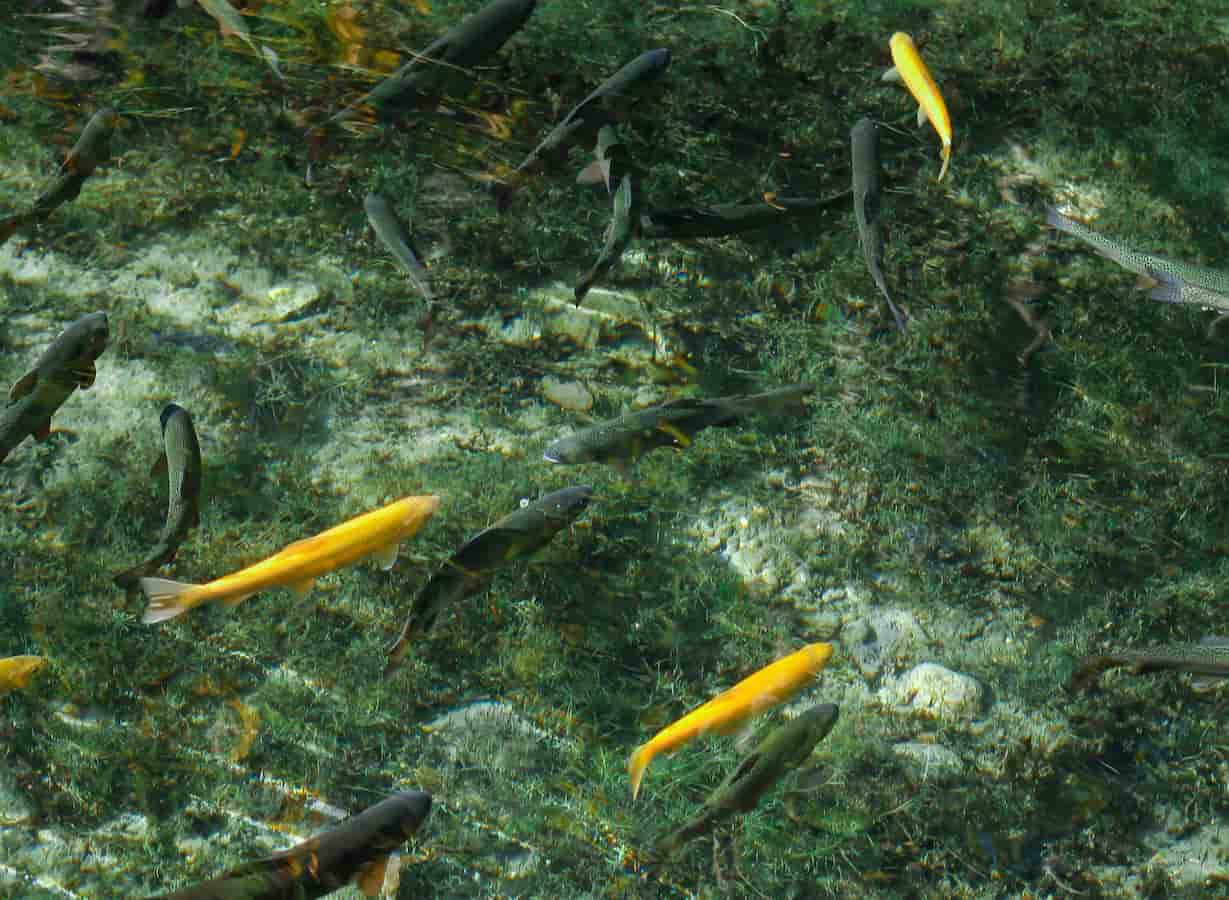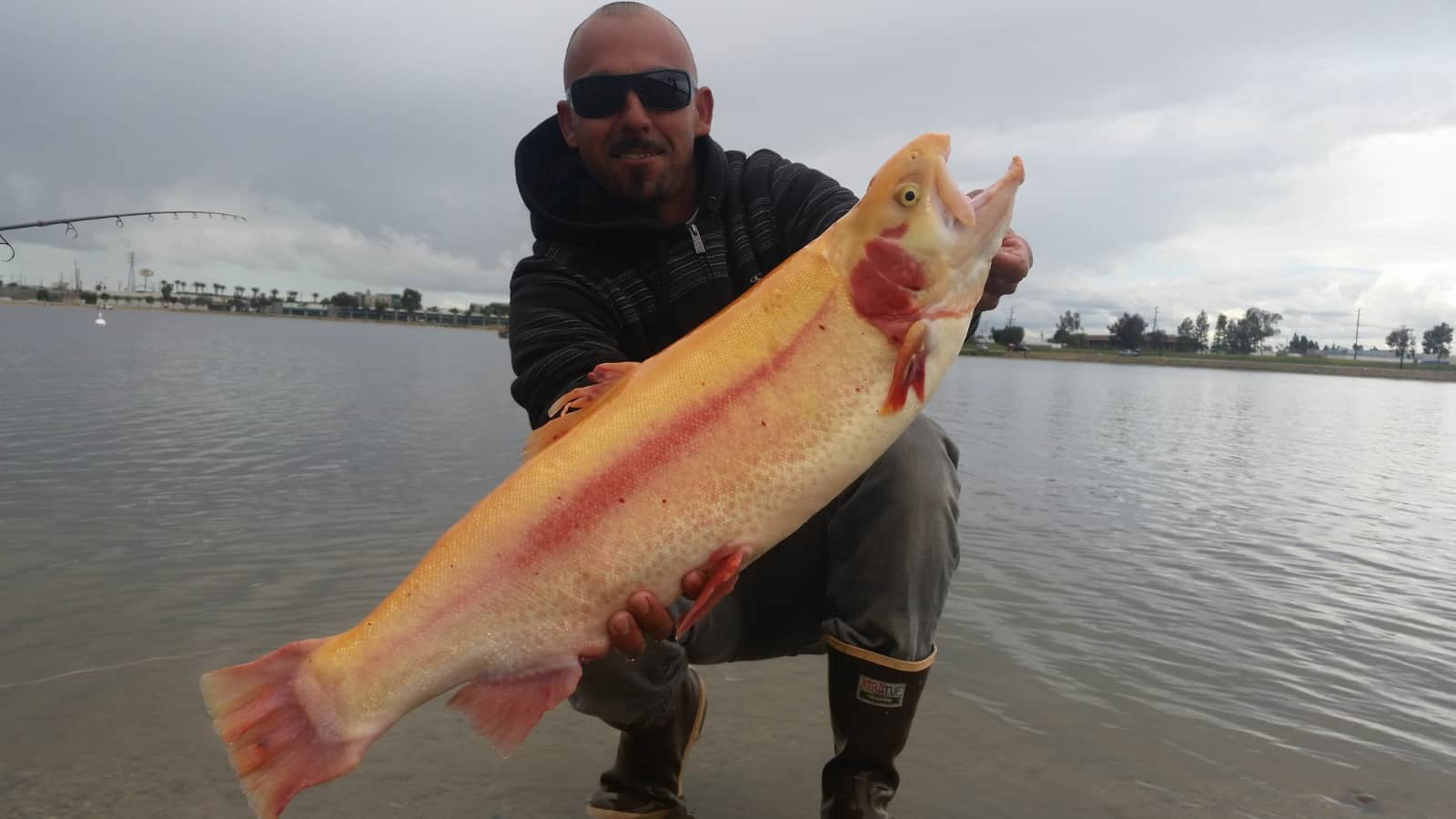Midas Mutants: A Case Study in How We Think Nature Needs Improvements

Image by Saya Omar
There are parallels between fish management and ungulate management. For example, the “beloose” project, is a cooperative venture between Maine and Canadian game managers resulting from hunter complaints about the dull coloration and diminishing size of moose in eastern North America. It involves lab fertilization of moose eggs with semen from Belgian Blue bulls and subsequent implantation of the embryos into moose uteri. The first beloose releases into the northern forest are expected in 2027. Harvesting one of these huge, gorgeous, cerulean trophies will be on the bucket list of every big-game hunter.
At this point, I should probably note that not a word of the previous paragraph is true. But if it got your attention, consider the disparity in public perceptions of warm-blooded wildlife and fish. Concocting and stocking genetic cocktails like beloose would be unthinkable, but it’s unquestioned and ongoing with fish.
That’s because for most of the public—including most anglers, managers, and environmental groups—fish don’t count as wildlife. They’re cold, slimy, unfeathered, unfurred, and unheard. Generally, their perceived purpose on this planet is to titillate humans by bending rods and posing on dinner plates.
Today the angling and fish-management communities tend to be deficient in what George Bird Grinnell in his 19th Century weekly, Forest and Stream, called “a refined taste in natural objects.” Hence: widely stocked and wildly popular man-made frankenfish such as “splake” (brook trout/lake trout hybrids, more often than not sterile), “tiger trout” (brown trout/brook trout hybrids, almost always sterile), “tiger muskies” (pike/muskellunge hybrids, usually sterile), “wipers” (white bass/striper hybrids, usually sterile), and “Golden Rainbows” (not hybrids, just pigment-bereft mutants that are sexually viable but too short-lived in the wild to reproduce).
Golden rainbows provide the most instructive case study. They have nothing to do with the genuinely beautiful golden trout native to the Kern River system—California’s state fish that a Cal. Fish and Wildlife Department team led by Dr. Phil Pister saved from certain extinction in the 1970s by eradicating the alien brown trout that outnumbered it 100 to one.
In early 1955, Vincent Evans, supervisor of West Virginia’s Petersburg Trout Hatchery, spied a jaundice-hued fingerling among thousands of rainbow trout. Instead of euthanizing it, he plucked it out and transferred it to the Spring Run Hatchery near Dorcas where hatchery workers there reared her in a separate tank and assigned her the apt name “Little Camouflage.” By the summer of 1956 she measured 14 inches. That October the hatchery workers fertilized 900 of Little Camouflage’s eggs with milt from normal rainbows, then selected mutant fry.
By 1963, West Virginia’s centennial year, the DNR had enough mutants to unleash thousands in the wild, proclaiming them to be “centennial golden trout.” Since then, they’ve been regularly stocked around the state. Anglers and managers rhapsodize about them. “The West Virginia Gold Rush returns April 1 – April 13, 2024, and is bigger and better than ever, with five times the number of chances to win prizes,” boasts the DNR. “During this two-week period, WV DNR will stock 68 lakes and streams with the Mountain State’s very own golden rainbow trout. This fish is prized by anglers for its unmistakable, bright-yellow color. 50,000 golden trout will be entering our lakes and streams, and this year, 500 fish will be tagged [for prizes].”
Despite the fact that West Virginia has 500 miles of productive native brook trout streams, it’s the non-native mutant that appears on the DNR logo.
Soon other states were demanding centennial golden trout. The name didn’t work outside West Virginia, so state and private managers came up with “palomino trout,” “banana trout,” “lightning trout,” and “thunder trout.” First to acquire broodstock was Pennsylvania.
This from Brian Wisner, hatchery director for the Pennsylvania Fish and Boat Commission: “Everybody likes them because they’re such an unusual fish.”
“Everybody” would include otters, eagles, ospreys, mergansers, herons, bass, walleyes, pickerel, pike, muskellunge, and gars, to mention just a few—a fact that Wisner didn’t conceal. “[Palomino trout] are very visible to predators,” he continued. “If you were trying to maintain a population in a stream, it wouldn’t be very successful because every predator out there sees them.”
Now golden rainbows are stocked across the U.S., and it’s nearly impossible to find any reference to them that doesn’t go on and on about how “stunning,” “gorgeous,” or “beautiful,” they are. “This year, the gorgeous golden rainbow trout we’re stocking in local ponds for Opening Day will bring added excitement to this time-honored Rhode Island tradition,” gushes the state Department of Environmental Management.
“This glowing fish with its bright colors is so beautiful that you have to tangle with a golden at least once in your lifetime,” effuses the Outdoor Passion TV show. “They look like a cross between rainbow trout and gold, making it a super fish. They are so visible near the surface it’s almost sight fishing.”
In some states the genetic manipulation of golden rainbows is carried even further by shocking eggs with hot water, thereby creating a third chromosome that results in “triploidy” and usually renders them sterile. Triploid fish attain freakish size by diverting energy from sex organs to growth. Triploid golden rainbows (AKA “lightning trout” and “thunder trout”) attain weights in excess of the biggest normal (diploid) rainbows.
Outdoor Writer Jim Matthews reports that Mt. Lassen Trout Farms in Red Bluff, California creates “the biggest and best rainbow trout available in the country… The Mt. Lassen Super Trout are unmatched in their health, vigor, and size. These huge, beautiful fish have broken the state record each of the past three years… [They] have been called many things from ‘Super Fish,’ ‘Behemoths,’ ‘Monsters,’ ‘Freakoids,’ to just plain huge, trophy trout. But the fact is they are ‘triploids.’”
While the name “freakoid” is eminently accurate, it rankles Mt. Lassen Trout Farms owner Phil Mackey. Our interview was strained. Reluctantly, he offered this: “We are producing very large trout, and our business is good. We did a really in-depth article with the Los Angeles Times. The reporter did a remarkable job; and the editor headlined it ‘Freakoid Trout.’ Most people didn’t even bother to read the well-written article. We were just branded. It’s not worth it. The demand for our trout right now is exceeding supply, so there’s no real benefit for us to try to get additional publicity. And the risk of negative publicity, as evidenced by that one claim, outweighs the positive. Almost a hundred percent of our fish are triploids. We weighed a fish the other day at 35 pounds. We have several fish much larger than the current state record.”
An ad from California’s pay-to-play Santa Ana River Lakes Trout Park, one of Mackey’s customers, reads as follows: “That’s right, we are bringing in those beautiful, golden-colored, Lightning Trout. If you haven’t caught a Lightning Trout, you’re in for the thrill of a lifetime. These fish are a bright golden color, with a bright red gill plate and a red stripe down the golden body of the fish. They look like neon lights shooting through the water.”

Triploidy was all the rage among native salmonid managers in the early 2000s. In 2002 The New York Times quoted Atlantic Salmon Federation’s Dr. Fred Whoriskey as follows: “This could be a win-win scenario in that taking the genetic, reproductive component in farm fish out of the picture in a cost-effective way would really protect wild fish, while having just a negligible effect on the salmon farming industry.”
Since then, Whoriskey and other researchers have learned that, in addition to sterility, triploidy causes diminished immunity, arrested gill development, skeletal deformity, and heavy predation. Recovery of seafaring triploid Atlantic salmon is between 12 and 24 percent of that for diploids. An Idaho Department of Fish and Game study found that 85 percent of stocked triploid rainbow trout “were presumed dead at 30 days post stocking.”
Nature doesn’t require human oversight. She knew what she was doing when she equipped critters with two chromosomes instead of three and when she made trout that didn’t glow like “neon lights.”
State Game and Fish agencies have information and education sections. When I was part of one in 1970s I learned that because I and my colleagues were fed and clothed by fishing, hunting, and trapping license buyers, “information and education” meant telling Massachusetts sportsmen what they wanted to hear rather than what they needed to know. Instead of defending their long-term best interests, we indulged their short-term appetites—like stocking non-habitat with snowshoe hares from Canada and attaching tags to hatchery trout that could be exchanged for such prizes as tackle boxes.
So except for the few state game and fish agencies financed mostly by tax dollars, curricula resemble that of schools at which students write teachers’ paychecks. That’s why “fisheries management” often includes saturating coldwater habitat with frankenfish.
If managers believe they need to concoct artificial fish bigger and more beautiful than those created by nature, how can we expect anglers and environmental groups to get behind recovery of critically imperiled native fish like the 14 surviving subspecies of cutthroat trout?
More often than not they don’t. For example, Idaho had traditionally stocked Henrys Lake with cutbows (sexually viable rainbow/cutthroat hybrids) because local anglers claimed (accurately enough) that they fight harder than the native Yellowstone cutthroats.
Eventually, ecological enlightenment began to dawn on Idaho fish managers, and they announced that they’d cease endangering Yellowstone cutthroats by dumping man-made mongrels on top of them. Local anglers waxed apoplectic, prevailing on the legislature to threaten the Fish and Game Department’s budget. So today the department stocks Henry’s Lake with triploid cutbows, appeasing anglers who assess fish worth merely by fish strength and providing Yellowstone cutthroats a measure of genetic protection.
Meanwhile, dozens of environmental groups oppose, impede, or block native-fish recovery because they fear and loathe the short-lived, easily neutralized organic piscicide rotenone, harmless to anything that respires without gills. These outfits haven’t bothered to learn that rotenone is almost always the only tool available to prevent native-fish extirpation or extinction and that, in modern fisheries management, it has never been seen to permanently affect an aquatic ecosystem except to restore it. Had they been active in the 1970s, California’s native golden trout—saved from extinction by rotenone—would probably not exist.
The worst offender has been Wilderness Watch, followed closely by Alliance for the Wild Rockies, Wolastoqey Mothers and Grandmothers of Quebec’s Micmac bands, Friends of the Bitterroot, Gallatin Yellowstone Wilderness Alliance, Western Environmental Law Center, Swan View Coalition, Friends of the Earth, Friends of the Wild Swan, Flathead-Lolo-Bitterroot Citizen Task Force, Conservation Congress, Yellowstone to Uintas Connection, Washington Toxics Coalition, Beyond Pesticides, California Watershed Alliance, Californians for Alternatives to Toxics, Center for Biological Diversity, Adirondack Council, and the Orwellian-named Wild Trout Conservation Coalition.
Golden rainbows do have one useful function. Chris Wood, president and CEO of Trout Unlimited explains: “The simple fact of this fish’s existence makes clear the need for more healthy and productive habitat so we can have more wild and native fish—not orange abominations reared in concrete.”
And golden rainbows (along with other Frankenfish) inspire Wild Fish Conservancy co-founder Kurt Beardslee — but only to ask these questions: “What is it about man-constructed fish that attracts anglers more than the beauty of native fish that evolved in these streams? We have to make up our minds. Do we want a circus environment with bizarre creatures to amuse us? Or do we want to restore healthy ecosystems?”
Frankenfish promo pouring out of game and fish departments and frankenfish effervescence from angling websites and publications render the answer apparent: We want the circus.











